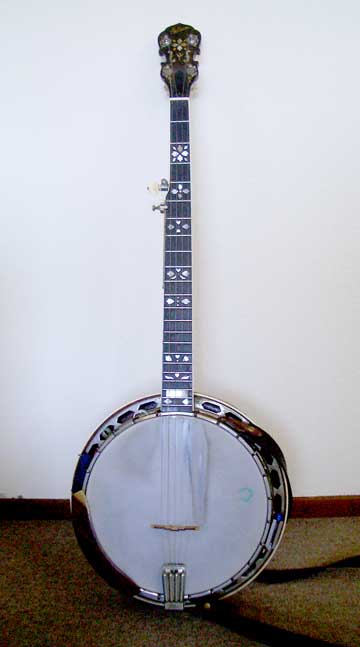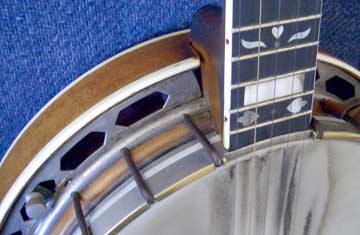My Banjo
Rick Shubb
I have a few banjos, including a Prucha, a Nechville
Phantom, a Gold Tone that sports the first ever graphite
neck, a Deering Calico, A Gold Star, a Saga travel banjo, and a nice new Huber that I got just a few months ago. I like each
of these banjos quite a lot, and each has something unique
to offer. But my main instrument,
by far, is my prewar Gibson.
|

|
I say prewar, although many of its parts are not
original. It is a conversion, and by no means a grail (ultimate collector's banjo). But it is a player's banjo, and
it sounds great.
When I bought it in 1964 from Jon Lundberg it was an archtop
plectrum. Jon converted it to a flathead using an Ode tone ring.
I shipped it to to Robby Robinson in Ohio who built the mahogany
5-string neck. Regrettably, the original neck was not preserved.
Most of us didn't think about such things in those days. It was
trashed and some of the inlays re-used in the hearts-and-flowers
5-string neck.
In the early 70s I replaced the resonator with a top-tension
style maple resonator built by Bob Palmer. The original mahogany
resonator, along with the original 40-hole archtop tone ring,
became part of another banjo that I sold. Again, I had not yet
developed much of a sense of history or respect for the antique
value of the instrument, and since these parts didn't serve my
needs, they were moved along to pay the bills.
If I had it to do over again, I would save all the parts. I'd
preserve the original plectrum neck, and duplicate it faithfully
as a 5-string. But I was a kid, and I wanted it to look like Earl's.
I can't remember now exactly what the plectrum neck looked like.
Maybe some banjo expert could help me figure
it out...
|
As for its present setup: of course,
I use my own 5th-string capo and compensated bridge. More on each
of those elsewhere on my site.
Its 5th string nut is in line with the (shortened) 5th fret,
a setup I prefer and recommend.
I use a clamshell tailpiece which is not the original (4-string.
long gone), but it is very old. It's the one I got in '64 when the neck was built.
The round green mark you see on the head at around 3 o'clock
is a Schertler pickup mounted on the inside of the head. The output
jack is in a clamp on the flange nearby.
A few years ago I added a wooden armrest made by Tom Nechville, which
is very comfortable and looks cool. I still have the original armrest around someplace.
I use a Remo Weather King head, and usually keep it just a lttle looser than most people do because it gives me the darker sound I like. I adjust the tension by feel and tone rather than tuning
it to a note, but I'm going to try that some time. I'm sure it's a good
method. My banjo has been sounding really good to me for quite
awhile, so I'm reluctant to change much about it.
The tuners are all Keith (Beacon Banjo Co.)
I use John Pearse strings: 09-11-14-20-10. I sometimes vary those gauges, depending on what style I'm playing more of at any given time or how strong my chops are, I may go heavier on the 1st or lighter on the 3rd.
I'm somewhat concerned about its 50-year-old neck. It's quite worn.
And it's never been exactly straight. It's not bowed or back-bowed,
but it has a dogleg. It doesn't cause an intonation problem, but
it places the first string too far from the edge, and the fourth
too close. So my left hand is more accurate on my other banjos,
but I sound better missing a few notes on this banjo than making
them on the others. A few years ago Larry Cohea made me a new nut,
which helped to correct this as much as possible, but it's still not ideal.
If it turns out that I must replace the
neck some day, I'd like to reproduce the original plectrum neck
as a 5-string. Now if only I could remember, or figure out exactly
what it looked like...
If you're an expert on old Gibson banjos, maybe
you could tell me more about it. I'd be curious to know. rick@shubb.com
I've been told that it was made in 1932 or 1933. Inside the
rim is stamped 9427-32. There is no oval sticker, but it may
have had one at one time.
I didn't take any pictures of the plectrum neck, and now 50
years later I'd like figure out what it looked like. I think
the banjo may have been a Studio King. That name has stuck in
my mind relative to this banjo for all these years, so it must
have been on there.
|
 |
The thin black line you see in this picture, around the rim, just below the edge of the head, is a plastic strip added by Jon Lundberg to adapt the shallower Ode tone ring, rather than remove any wood from the rim.
The entire pot assembly was just like pictures of
Studio Kings I've seen:
(http://www.turtlehillbanjo.com/images/A16-19/StudioKing.html):
Same tone ring, same resonator, same tube and plate flange with
hexagonal holes. |
But I'm pretty sure that the peghead was not
that of a Studio King, and I'd almost swear that the neck had
the word Gibson and maybe Mastertone somewhere
on it. As a teenaged Scruggs fanatic, I don't think I'd have
been savvy enough to buy it if it didn't have one or both of
those words reassuringly identifying it.
I guess I could be mistaken about some of this; I've seen lots
of old banjo necks over the years. But I'll bet it was one of
those Gibson anomalies: a pairing of neck and rim that was not in the catalog.
Some of the inlays were reused in the 5-string neck (above).
They were some version of hearts-and-flowers. Any ideas, banjo
people? When was it built? What did the neck look like? What
the heck was it? rick@shubb.com
Old banjos vs. new banjos
To me, the best sounding banjos are old banjos. Some new banjos
do sound better than some old banjos, and of course setup is a
big factor. Certainly the player is the single most important
tonal factor. But everything else being equal, old banjos sound
better to me. There is more of a difference in playing them than
just listening. It's as much a matter of feel and response as
it is one of tone.
I don't think that banjos were built better before World War
II. I think they're being built better now. But the magic ingredient
is time. Time and use. All good instruments improve with time
and use. If you take one of today's good banjos - and there are
many good ones - and play it for five years, it will sound much
better. Incidentally, so will you. Ten years, better yet. And
so on. In another fifteen years many of the banjos being built
today will probably sound as good as prewar Mastertones sound now.
On those early Flatt & Scruggs records, Earl's banjo was
not yet 20 years old. Microphones of that era were not as accurate
as today's, but then again, an oil painting is not as accurate
as a photograph. Besides, when it comes to tone, the Earl factor trumps all.
|
|
|
| |
| |
|
| |